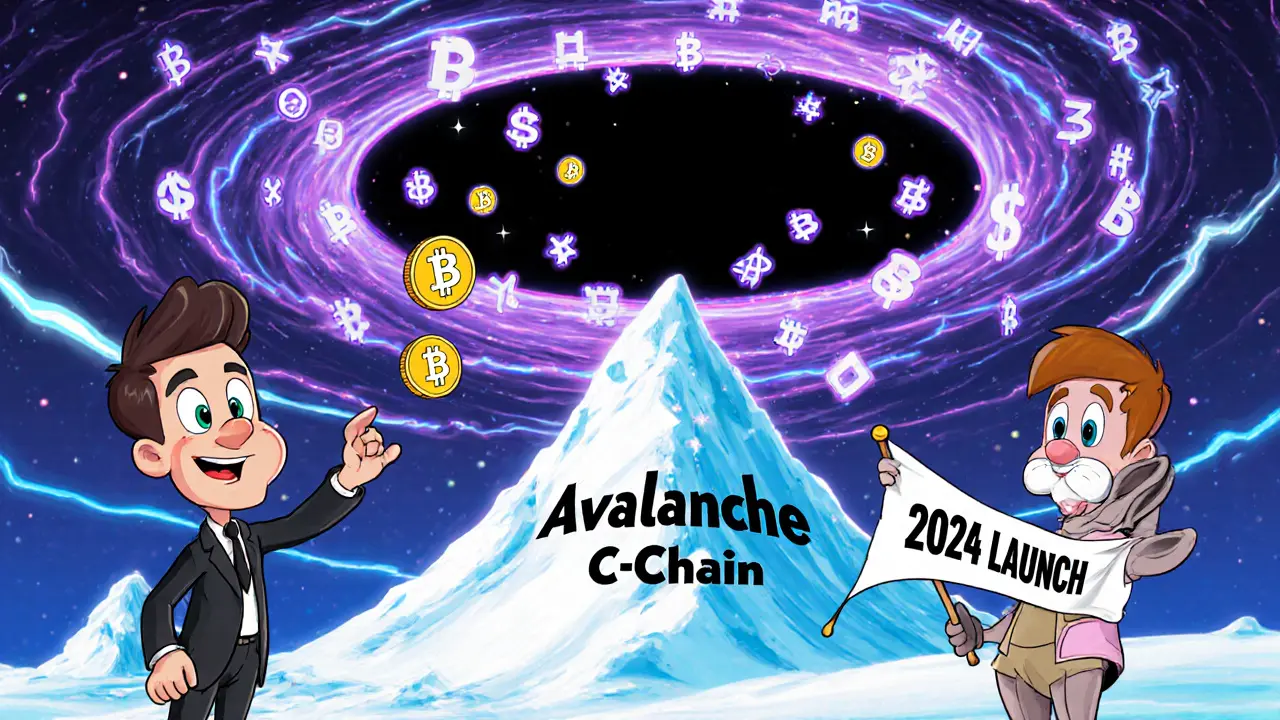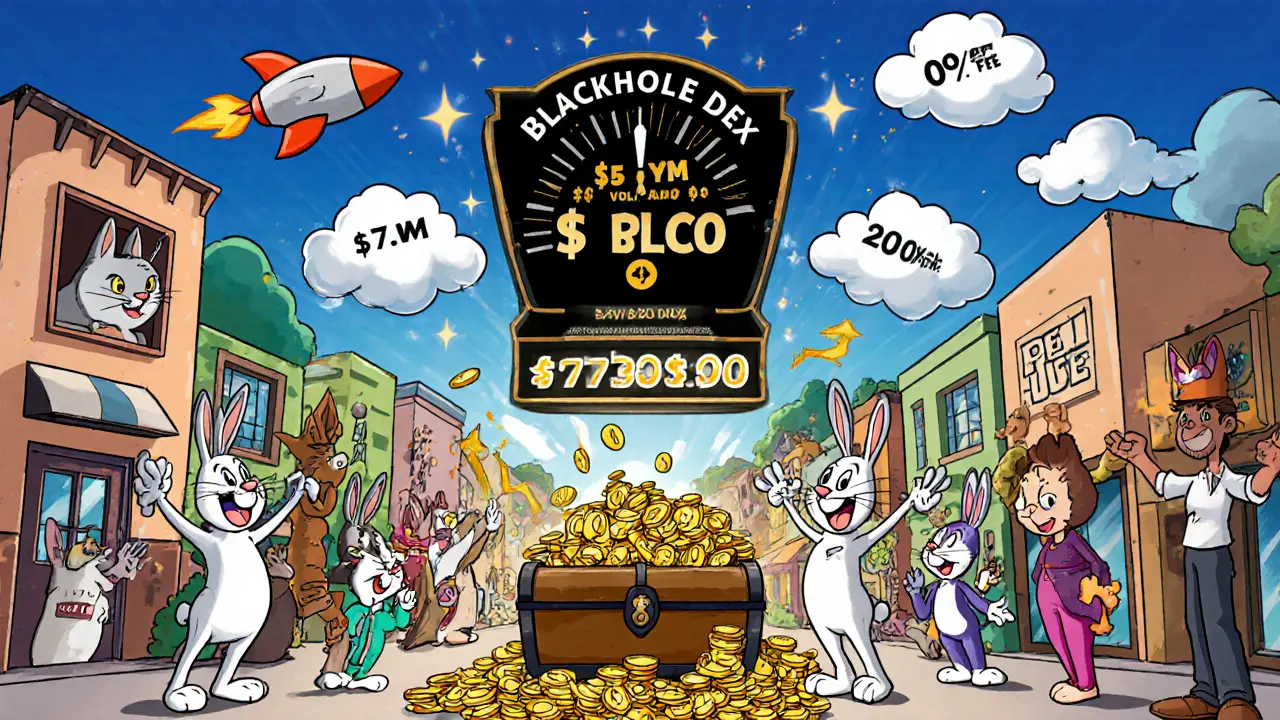
veNFT Comparison Calculator
Blackhole veNFT Comparison
Compare benefits of Singularity vs Supermassive veNFTs based on your $BLACK holdings and lock strategy.
Comparison Results
Select your options and click 'Calculate Comparison' to view results.
Key Differences:
Singularity: Time-locked (up to 4 years), proportional voting power based on lock duration, can withdraw after lock expires. Supermassive: Permanent lock (burned $BLACK), non-decaying voting power, 10% reward rebase bonus.
If you’ve been scrolling through DeFi dashboards lately, you’ve probably spotted a surge in activity around a new DEX called Blackhole. Launched in 2024 on Avalanche’s C‑Chain, it promises community‑owned liquidity, an innovative token‑omics model, and a soaring TVL that rivals the network’s biggest protocols. This Blackhole crypto exchange review cuts through the hype to show you exactly how the platform works, what the numbers say, and whether it’s worth a slice of your portfolio.
Key Takeaways
- Blackhole operates on Avalanche C‑Chain, offering sub‑second finality and low fees.
- The native $BLACK token fuels a dual‑layer ve(3,3) model that rewards long‑term commitment.
- TVL sits around $47.6million, with 24‑hour DEX volume exceeding $68million.
- Community ownership is total - the founding team burned all team tokens into Supermassive veNFTs.
- Complex governance (Singularity vs. Supermassive veNFTs) can be a barrier for newcomers.
What Is Blackhole (CLMM)?
Blackhole (CLMM) is a decentralized cryptocurrency exchange built on the Avalanche C‑Chain a high‑throughput, low‑cost blockchain that supports EVM‑compatible smart contracts. Launched in 2024 by Alex Becker and Ellio Trades, the platform is structured as a community‑owned project incorporated in the Cayman Islands. It runs a constant‑product liquidity‑maker (CLMM) engine, meaning traders interact directly with pooled liquidity rather than relying on order books.
Core Tokenomics - The Role of $BLACK
The backbone of Blackhole’s incentive system is the $BLACK the native governance and emission token of the Blackhole protocol. $BLACK serves four distinct purposes:
- Emission rewards for liquidity providers (LPs).
- Stakeable asset that generates a share of protocol revenue.
- Collateral for creating vote‑escrowed NFTs (veBLACK).
- Burnable resource to mint Supermassive veNFTs with permanent voting power.
All these functions sit under a ve(3,3) tokenomics a hybrid model that combines vote‑escrowed token incentives (ve) with the game‑theoretic principles of the 3,3 protocol. Every epoch, emissions increase by roughly 3%, rewarding participants who lock more $BLACK for longer periods.

Two‑Tier Governance - Singularity vs. Supermassive veNFTs
Governance revolves around veBLACK vote‑escrowed NFTs created by locking $BLACK tokens. Holders can mint one of two NFT types:
- Singularity veNFTs: Users lock $BLACK for up to four years, earning proportional veBLACK voting power and a cut of protocol fees. The longer the lock, the higher the voting weight.
- Supermassive veNFTs: Created by permanently burning $BLACK. These NFTs grant non‑decaying voting power, a 10% rebase bonus on rewards, and premium access to governance proposals.
This bifurcated approach lets risk‑averse participants choose flexibility (Singularity) while power users can lock in permanent influence (Supermassive). The system aims to align incentives across short‑term liquidity provision and long‑term protocol health.
Performance Metrics - TVL, Volume, and Fees
Blackhole’s on‑chain data tells a compelling story:
- Total Value Locked (TVL) the total amount of assets deposited in the protocol: $47.66million (Avalanche‑only).
- 24‑hour DEX volume: $68.44million.
- 7‑day volume: $185.01million.
- 30‑day volume: $191.96million.
- Cumulative fees (24h/7d/30d): $43,078 / $104,917 / $109,692.
- Annualized fee & revenue projection: ~ $1.34million.
These figures place Blackhole in the 83rd percentile for both volume and order‑book depth on CoinGecko, with an average bid‑ask spread of 0.611%-competitive for a nascent DEX.
User Experience - Pros, Cons, and Common Pain Points
Real‑world feedback paints a mixed yet optimistic picture. Users love the passive‑income avenues:
- Liquidity mining rewards that compound via the 3% emission boost each epoch.
- Staking $BLACK to capture a slice of protocol revenue.
- Voting rights that let token holders influence borrower selection and fund allocation.
However, the steep learning curve around veNFT creation, lock periods, and the distinction between Singularity and Supermassive NFTs can be intimidating. A typical newcomer might spend several hours watching YouTube tutorials before feeling comfortable navigating the “Gauge” voting dashboard.
On the upside, the community is highly active. Both founders frequently host AMAs, and third‑party channels churn out step‑by‑step guides. The platform’s UI is clean, with a one‑click “Add Liquidity” flow, but the governance tab still feels like a mini‑DApp that requires extra attention.
How Blackhole Stacks Up Against Other Avalanche DEXs
| Feature | Blackhole (CLMM) | Benqi | Uniswap (Avalanche) |
|---|---|---|---|
| TVL (USD) | $47.6M | $120M | $95M |
| Supported Coins / Pairs | 41 coins / 67 pairs | 30 coins / 45 pairs | 55 coins / 120 pairs |
| Governance Model | ve(3,3) with Singularity & Supermassive veNFTs | Standard DAO voting (BLID) | Uniswap DAO (UNI) |
| Fee Structure | 0% market fees, revenue shared with LPs | 0.3% swap fee, 0.05% protocol fee | 0.3% swap fee |
| Community Ownership | 100% - team tokens burned into Supermassive veNFTs | ~30% team reserve | ~15% team reserve |
Blackhole’s unique selling point is the total community ownership and the two‑tier veNFT system, which none of the competitors currently offer. In raw TVL it lags behind Benqi and Uniswap, but its growth rate-up from $11M to $47M in just a week-suggests it could close the gap quickly.

Potential Risks and Red Flags
- Complexity: The ve(3,3) model demands a solid grasp of token‑locking economics; mis‑timed locks can reduce effective APR.
- Liquidity Concentration: While volume is high, most liquidity resides in a handful of popular pairs, leaving niche assets thinly traded.
- Regulatory Ambiguity: As a Cayman‑incorporated DeFi protocol, Blackhole operates in a gray area without explicit licensing.
- Smart‑Contract Risk: New code paths for veNFT minting have seen limited audits; a breach could affect locked $BLACK.
Getting Started - A Quick 5‑Step Checklist
- Set up an Avalanche‑compatible wallet (e.g., MetaMask on the C‑Chain).
- Bridge or acquire $AVAX for gas and $BLACK for participation.
- Visit the Blackhole UI, connect your wallet, and add liquidity to a preferred pool.
- Lock $BLACK for a Singularity veNFT (up to 4years) or burn $BLACK to mint a Supermassive veNFT.
- Visit the Governance tab, vote on active gauges, and monitor your reward distribution each epoch.
Following this checklist gets you into the reward loop within minutes, but remember to read the official docs and community guides for the fine print.
Frequently Asked Questions
What blockchain does Blackhole run on?
Blackhole is built on the Avalanche C‑Chain, taking advantage of its fast finality and low transaction fees.
How do I earn rewards on Blackhole?
Provide liquidity to any supported pool, lock $BLACK into a Singularity veNFT or burn it for a Supermassive veNFT, and vote on gauge allocations each epoch. Rewards come from emission boosts, protocol fee sharing, and staking revenue.
What’s the difference between Singularity and Supermassive veNFTs?
Singularity NFTs are time‑locked (max4years) and earn voting power proportional to lock length. Supermassive NFTs are created by permanently burning $BLACK, granting non‑decaying voting power, a 10% reward rebase boost, and permanent governance influence.
Is there any market fee when I trade on Blackhole?
Blackhole advertises a 0% market fee; instead, the protocol distributes generated fees to liquidity providers and veBLACK holders.
Can I withdraw my locked $BLACK before the epoch ends?
For Singularity NFTs, you can withdraw after the lock period expires; early withdrawal incurs a penalty that reduces both rewards and voting power. Supermassive NFTs are permanent-once burned, they cannot be reclaimed.
Final Thoughts
Blackhole packs a lot of innovation into a relatively young protocol. Its community‑first stance, combined with the ve(3,3) incentive model, gives early adopters a genuine slice of governance and revenue. The numbers back up the hype: rapid TVL growth, solid volume, and fee generation place it among Avalanche’s top DeFi players. If you’re comfortable navigating a multi‑step lock‑and‑vote system, Blackhole offers compelling yields and a chance to influence protocol direction. For risk‑averse traders who prefer plug‑and‑play swaps, the complexity might be a deterrent. In either case, keep an eye on how the platform scales its liquidity and whether its governance mechanisms stay resilient as the user base expands.

Melanie Birt
October 13, 2025 AT 02:06Alright, let’s break down the veNFT lock mechanics. First, the time‑locked Singularity gives you voting power that scales with lock duration, so a 4‑year lock is way stronger than a 0.5‑year one. 🚀
Second, the Supermassive version is permanent – you burn $BLACK and get non‑decaying power plus that 10 % rebase bonus.
Make sure you calculate the ROI based on your staking horizon, because the longer you lock, the higher your APY potential.
If you’re risk‑averse, stick with Singularity and plan an exit; if you’re all‑in, go Supermassive and enjoy the steady rewards.